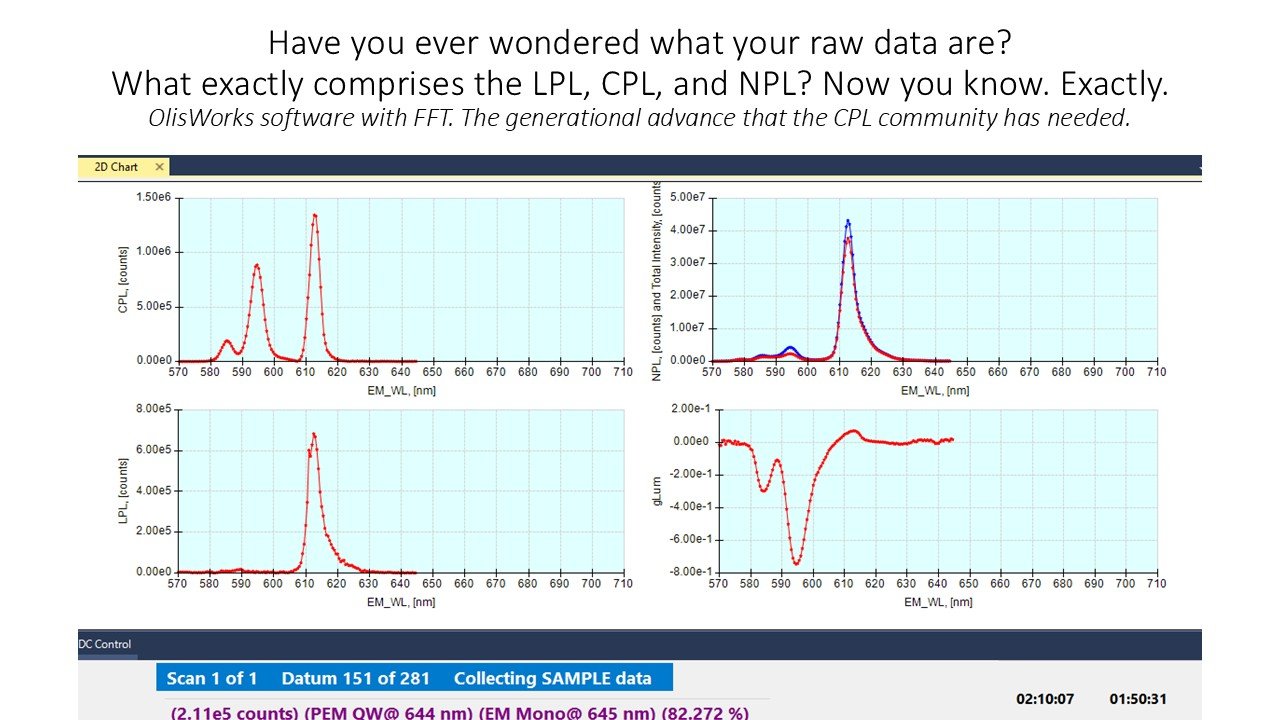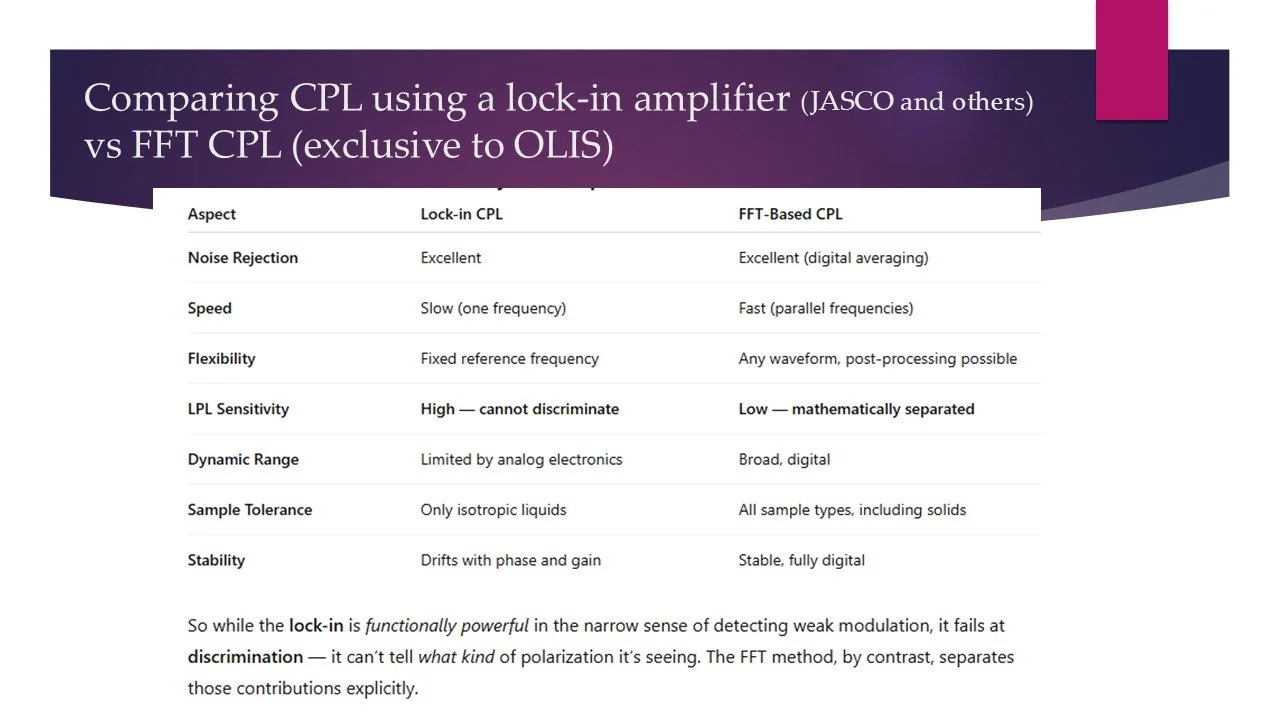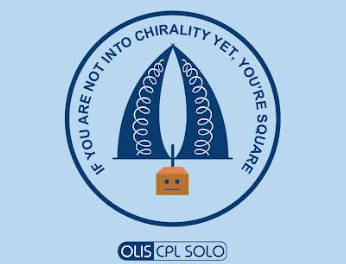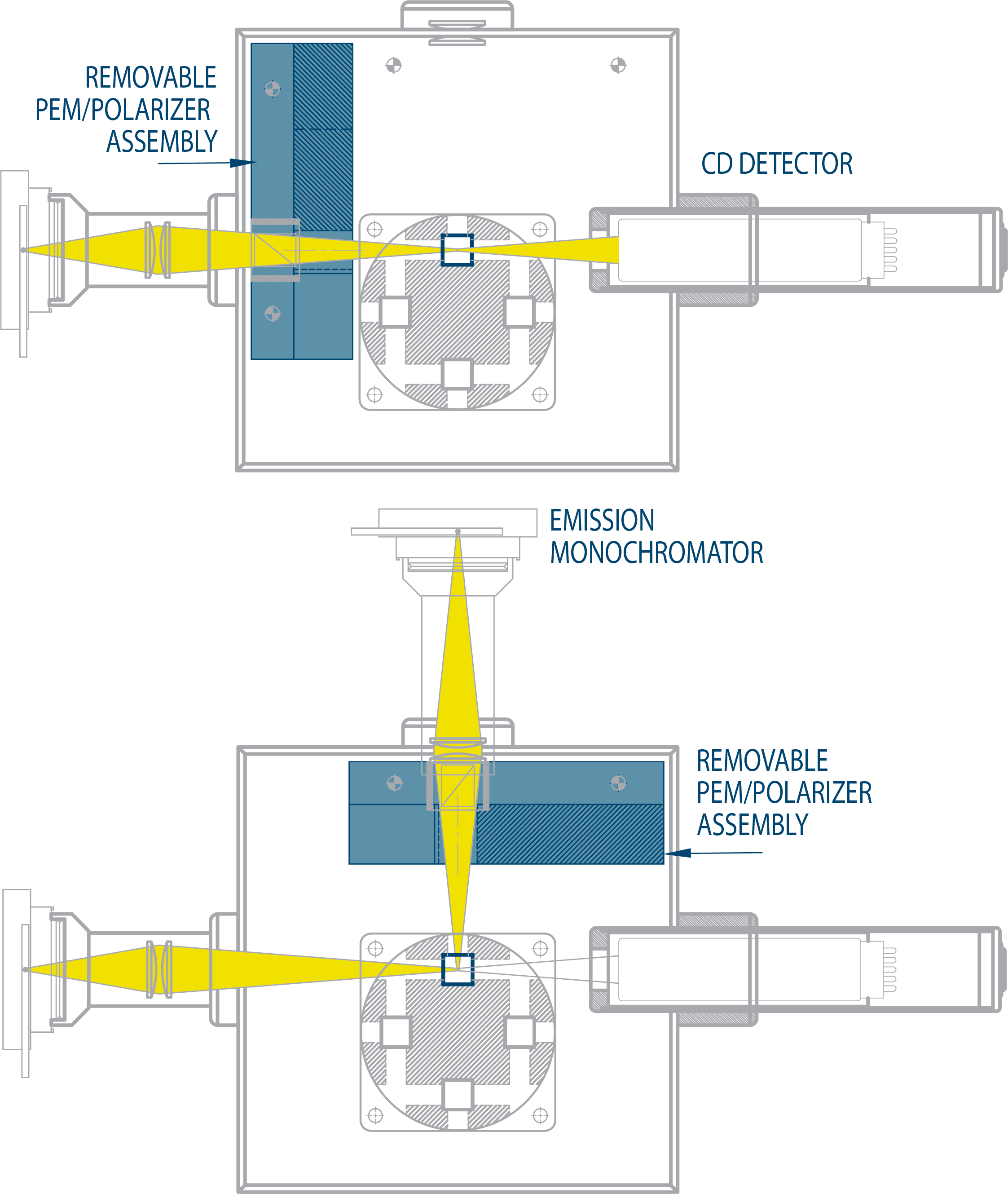The Source of Error: Linear Polarized Luminescence (LPL)
LPL originates whenever a luminescent sample is anisotropic or excited by non-isotropic light. Even weak sample alignment or stress can produce strong linear polarization of the emitted light. Because LPL amplitudes are often 10–100× greater than CPL, even a small leakage of LPL into the circular channel distorts the apparent gLUM.
CPL spectrometers employ a photoelastic modulator (PEM) or rotating waveplate to alternately pass left and right circular polarizations to a single photomultiplier detector. When resulting modulated signal is recovered by a lock-in amplifier synchronized to the modulation frequency, the assumption is made that all modulated intensity originates from circular polarization. When LPL is present, its intensity fluctuations occur at the same reference frequency, and the lock-in amplifier cannot distinguish their origin. The two signals become inseparable in the analog domain. In short: the physics of the lock-in method make LPL contamination unavoidable.
As early as the 1980s, we had the fortune of good working relationships with Ari Gafni and then Riehl and Richardson, who pioneered the idea and use of circularly polarized luminescence. Among the first to purchase prototype OLIS CPLs was G. Muller at SJSU and Peter Osvath at CSIRO.
Because the market was so tiny, and because people who were interested in CPL were also interested in CD, we did not produce a stand-alone CPL.
Our first approach was to create a spectrometer which was a convertible model, switching elegantly between CD and CPL. The approach we took was to create a sample compartment with repositionable polarization hardware. We named the sample compartment the Polarization Toolbox.
In the Polarization Toolbox, there is a polarizer mount before the sample to excite the measurement beam and a second mount after the sample to excite the emission. Likewise, there are two positions for the PEM: before the sample to modulate the polarized light Abs(L) and Abs(R) and after the sample to modulate the polarized emission Em(L) and Em(R).
(Yes, in addition to CD and CPL, one can use this hardware for anisotropy and FDCD.)
Over the decades, a few dozen research laboratories purchased the resulting OLIS DSM 172 UV/Vis/NIR CD with UV/Vis CPL, and later the OLIS DSM 245 UV/Vis CD with CPL. Then, in 2018, the idea occurred to us to revisit a dedicated CPL spectrometer. The resulting CPL Solo is a small and affordable emission-only model with none of the large and expensive hardware required for CD.
Since the 1990s, data collection on all OLIS CD and CPL spectrometers is as perfectly digital as technology allows. No analog lock-in amplifier is required or used. Thus, in CD and in CPL, OLIS software is acquiring raw data. This is a huge advantage over the other products which can only return to the researcher already processed data and which cannot collect CD or CPL on first principle.
NEW!! This advantage has found its greatest fulfillment in the 2025 OlisWorks for CPL using FFT.
Because our equipment acquires the raw data, we have ultimately freedom in how to process it. For CPL, this means that we can apply Fast Fourier Transform to separate mathematically – perfectly – the CPL, LPL, and NPL. Finally! The greatest challenge to accurate gLUM calculation has been eliminated!
The FFT-Based Solution to LPL Contamination – Unique to OLIS
The OLIS system method abandoned analog phase-sensitive detection decades ago. Now, the emission intensity is sampled directly in the time domain using digital photon counting. This produces a raw waveform containing all polarization modulations—CPL, LPL, and noise. We knew that our hardware did not contribute LPL, because our excitation source is a nonpolarized LED. However, close reading of Feldmann’s 2023 work reminded us that many labs handle samples with inherent LPL. Thus, we returned to an idea we had considered years ago: applying a fast Fourier transform (FFT) to the raw data to segregate the data into CPL and LPL components, which appear at distinct frequencies or phase relationships.
Mathematical filtering can then isolate the true CPL contribution and completely remove the linear polarization artifacts. This digital approach has several advantages:
• Perfect mathematical separation of CPL and LPL components
• No lock-in amplifier (no phase drift, no mixing of frequencies)
• No analog-to-digital conversion errors
• Wider dynamic range because signal magnitude is not limited by the linearity of analog circuitry
The result is the first detection method that is theoretically correct for chiral emission spectroscopy.
Watch this Video and more at here.
Unique Sample Compartment to Ease the Addition of CPL to a CD spectrometer:
Unique Sample Compartment to Ease the Addition of CPL to a CD spectrometer:
We love modularity. We love to minimize waste. So we set out to add CPL to our CD spectrometer, dual-purposing the polarizers and PEM.
This led to the development of the Polarization Toolbox, a unique sample compartment which allows failsafe and fast positioning of the polarization hardware before the sample -- for CD -- and after the sample -- for CPL.
When we decided to produce a stand-alone CPL, we continued to employ the roomy Polarization Toolbox chamber. But we replace the broadband light source and double monochromator required for CD with a wavelength specific LED better suited to CPL. Simple. Stable. Suitable.
OLIS Circularly Polarized Luminescence Spectrophotometers
Technologically superior, smaller, and less expensive than all commercial alternatives
At the encouragement of Muller, Riehl, and others in the early 2000s, On-Line Instrument Systems (OLIS), Inc. added CPL spectrometers to our product line.
We started by developing a sample compartment which allowed positioning of the polarization hardware before the sample -- for CD -- and after the sample -- for CPL.
We call this sample compartment a “Polarization Toolbox.” This Toolbox can be configured for both polarized measurement light (CD) and polarized emitted light (CPL) with no hardware additions.
After producing and selling a number of models for both CD and CPL, in 2019, we added the CPL Solo. This emission-only model has none of the large and expensive hardware required for CD but also employs the Polarization Toolbox.
Polarization Toolbox
This sample compartment was developed to eliminate any redundancy of hardware for CD and CPL measurements. Instead of duplicating hardware, one positions the polarizers and the photoelastic modulator (1) before the sample, (2) after the sample, or (3) out of the optical train.
This open-architecture design eliminates the cost and redundancy of two photoelastic modulators, as is used in the Jasco and Applied Photophysics CPL systems (read more on this ahead).
The Polarization Toolbox is also an excellent pedagogical resource. With one instrument, one can move among absorbance, fluorescence, anisotropy, circular dichroism, and circularly polarized luminescence simply by adding or repositioning the polarization pieces. The repositioning of the polarizer(s) and PEM requires no tools, optical alignment, calibration, or other process. It is easy and quick.
(However, should you prefer to purchase two PEMs so as to avoid repositioning one between CD and CPL measurements, you are free to do so.)
The photographs (at right) show the interior of the Polarization Toolbox with its lid removed. Here we see an optional four position cell holder. CPL experiments can be very lengthy, so controlled temperature(s) can be quite desirable. This four position Peltier holder allows one to do up to four experiments without user intervention.
Choose a single or 4-position Peltier for computerized temperature control, so as to hold a sample at a given temperature over hours of data collection or to vary temperature for a thermal melt or other temperature dependent study.
Moving the polarizer
Moving the PEM
Optimize for Sensitivity (CPL) or Stray Light (CD)?
Circularly polarized luminescence (CPL) demands highest sensitivity. Thus, the ideal instrument has minimal optical surfaces (mirrors and gratings) as well as the highest intensity light sources.
On the other hand, circular dichroism (CD) demands very low stray light, which is achieved using a double monochromator plus the high intensity light source.
The two OLIS instruments that support both CD and CPL therefore include a double monochromator. These double monochromators required for CD produce the excitation light for CPL.
The OLIS DM 245 uses the small Hummingbird subtractive double grating monochromator with a spectral range of 170-700 nm or 200-900 nm. As a “subtractive” double, this monochromator creates a homogeneous output beam, independent of the spectral bandpass. An ‘additive’ double monochromator produces a heterogeneous output beam, so that wavelengths within a bandpass are spatially separated.
The OLIS DSM 172 uses the classic Cary 14/17 prism-grating additive monochromator with spectral range of 185-2600 nm, making it the ideal choice for laboratories working in the NIR region.
Our model which does not support CD – the OLIS CPL Solo – has no large, expensive double monochromator because it is optimized expressly for sensitivity. Compare this with the Jasco CPL-only model – the CPL-300 – which has TWO double monochromators, yet ironically, does not support CD acquisition.
The fewer optics the excitation passes through, the higher the sensitivity. Thus, on a model from which CD is not expected, a laser or a (filtered) LED is used for highest intensity excitation light. The elimination of large and expensive CD-specific hardware with low cost, high intensity LEDs is what allows us to create the low priced CPL Solo.
Excitation Light from Monochromator or LED
Highest intensity excitation is achieved using a bright light source and minimal optical surfaces. There is a need for large and expensive double monochromators in CD and high-resolution fluorescence spectrometers. There is no need, and in fact no good reason at all for these monochromators in a CPL. For CPL, filtered LEDs -- inexpensive, incredibly stable, and brilliantly intense – is the better choice.
The resulting high performance, small & affordable OLIS CPL is the CPL Solo.
Optimizing for Sensitivity means the right detector
For the UV/Vis, OLIS uses a gated photon counting Hamamatsu photomultiplier tube. There is no detector for the 230-870 nm region with higher sensitivity. It is exactly right for the job.
For the NIR CPL Solo, OLIS uses an InGaAs detector with OLIS electronics. This detector opens up a range of 600-1600 nm with sensitivity on par with the photon counter.
Only OLIS models collect directly, absolutely, and entirely digitally.
OLIS software eliminates need for 1960s era lock-in amplifiers to decouple and modify the raw signal before it reaches the detector. Our entirely digital method eliminates 100% concern about calibration, G-factors, and incorrect user
settings. It is used in our CD and CPL systems.
OLIS software tags every raw datum for time, wavelength, and state of polarization. Originating from the raw data and
modified only mathematically, the resulting digitally acquired answer is perfect.
For CD, the digital OLIS method is exactly
abs(L) – abs(R) = CD
No calibration ‘k’ is required.
For CPL, the digital OLIS method is exactly
fluo(L) – fluor(R) = CPL.
No G-factor is required.
OLIS DM 245 in CD MODE PEM is between incoming light and the sample, creating polarized measurement light.
OLIS DM 245 in CPL MODE PEM is between the sample and the emission monochromator, analyzing polarized emitted light.









